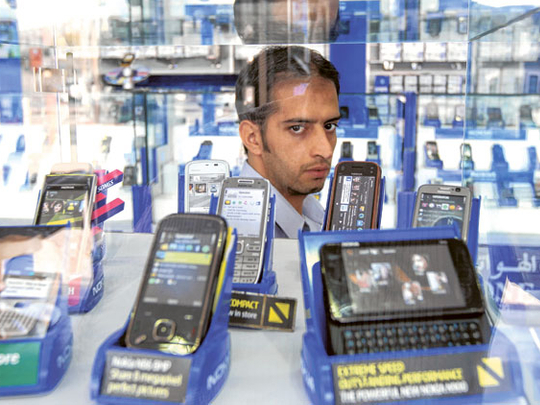
Dubai: Sales of mobile phones in the Middle East and Africa performed better than expected, totalling 47.11 million units in the third quarter of 2011, an increase of 19.20 per cent compared to 39.52 million in the same period last year as non-smartphone devices performed well, driven by demand for low-cost devices from white-box manufacturers and for dual-subscriber identity module (SIM) devices.
"The third-quarter smartphone sales were less-than-expected as customers were put off by Apple iPhone 4S and some consumers held off upgrading in the third quarter because they were waiting for promotions on other new high-end models that were launched in the run-up to the fourth quarter holiday season," Annette Zimmermann, principal analyst at Gartner based in Munich, told Gulf News.
Smartphone sales to end users reached 7.22 million in the third quarter of 2011, up 66 per cent from 4.33 million during the third quarter of 2010.
Despite a drop in market share, Nokia remained the leader in mobile device sales, accounting for 55 per cent. Samsung was second with 14.1 per cent, followed by RIM with 4.3 per cent and ZTE with 4.20 per cent by overtaking LG. LG recorded 3.40 per cent market share.
The second quarter of 2011 was the low point for Nokia, and the third quarter brought signs of improvement. Dual-SIM phones in particular, and feature phones generally, maintained Nokia's momentum. Heavy marketing from both Nokia and Microsoft to push the new Lumia devices should bring more improvement in the fourth quarter. However, a true turnaround won't take place until the second half of 2012.
Zimmermann said Nokia shipped 18 million dual-SIM phones globally in the third quarter.
Nokia loyalty
In the smartphones segment, Nokia still rules the roost, albeit at a slower pace, with 34.9 per cent of the market followed by RIM with 28.3 per cent, Apple with 11.6 per cent and Samsung with 8.6 per cent.
Samsung became the No 1 smartphone manufacturer worldwide but in the region customers are still loyal to Nokia.
In addition to the strong growth of smartphone sales, said Zimmermann, increasing sales of whitebox products drove sales of mobile phones upward once again.
"In the third quarter, strong shipments of whitebox manufacturers from China and India continued to expand their reach beyond their boundaries. White-box manufacturers contributed more than seven per cent to the total sales with 3.4 million units," she said.
Among the operating systems, Symbian still leads with 35.20 per cent followed by RIM with 28.30 per cent, Android with 21.80 per cent and iOS with 11.60 per cent.
Globally, Android OS accounted for 52.5 per cent of smartphone sales to end users in the third quarter of 2011, more than doubling its market share from the third quarter of 2010. Symbian could only manage 16.9 per cent.
"Over the years, manufacturers have been concentrating on the high-end side of the market growth in the smartphone category. In order to reach the mass market, manufacturers will strategically look at reducing the migration/entry price barrier with a slew of mid-range and lower end smartphones. What we will see in the smartphone market will be a parity in relation to customer segment vis-à-vis functional sophistication of smartphones.
Holiday season
"This is not the same with all manufacturers pushing the boundaries of technology and innovation in 2011 we will see mobile phone users finding compelling reasons to turn in their older models, thereby fostering greater competition and offering a wider selection for consumers," Mohammad Kais Zribi, regional manager, HTC Middle East and North Africa, said.
The fourth quarter looks promising, she said, mainly due to the holiday season. We believe Apple will bounce back in the fourth quarter because of its strongest ever pre-orders for the iPhone 4S in the first weekend after its announcement. Markets such as Brazil, Mexico, Russia and China are becoming more important to Apple, representing 16 per cent of sales and showing that the iPhone has a place in emerging markets, especially now that prices have been cut for the 3GS and 4.
"We have revised our forecast for the fourth quarter due to strong demand. Total sales for 2011 are expected to be around 180 million, of which 30 million will be smartphones," she said.
"The year-end demand for mobile handsets will support continued sales growth. Similar to the previous quarter, the fourth quarter market for mobile phones is continuing to increase. Samsung expects to double its sales of smartphones this year," Kyung Tae Bae, president and CEO of Samsung Middle East and North Africa, said.
Nokia is expected to launch Lumia 800, which runs on Windows 7.5 (Mango) only next year in the region as N9 is doing brisk business. "The phone which we have reviewed," she said, "has some excellent features plus the price point."
Sony has done a good move by taking control of Sony Ericsson. By taking full control, she said, Sony can integrate its smartphone operation with its tablet, hand-held game console and personal computer businesses to save on costs and better synchronise development of mobile devices. The move comes as Sony's competitors such as Apple and Samsung forge ahead with closely coupled strategies for smartphones and tablet computers.











